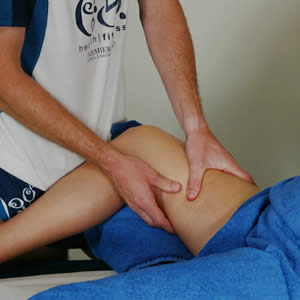Sports Massage
Sports massage differs from other forms of massage in the fact that it concentrates on the specific needs of the athlete. With the ever growing competitiveness and intensity of physical exercise, the demand for sports massage is also increasing and becoming recognised as a skill and practice which may aid recovery and enhance performance. To perform sports massage, it
is especially important to have a thorough understanding of anatomy and
physiology, in particular the muscular and skeletal systems. Through
understanding these systems and the effects of exercise upon them, the
masseur can directly target the areas where specific damage has been done
and maximum benefit may be gained.
To perform sports massage, it
is especially important to have a thorough understanding of anatomy and
physiology, in particular the muscular and skeletal systems. Through
understanding these systems and the effects of exercise upon them, the
masseur can directly target the areas where specific damage has been done
and maximum benefit may be gained. Athletes looking to improve their performance spend days working to produce a structured plan, months building up a base, weeks developing top end speed and hours in the intensity of competition. Yet few consider a thirty-minute massage as part of their programme.
Thousands of pounds are spent on the tools of the trade; disc wheels, carbon frames, sexy wheels, the latest kit. Yet £25 spent on a sports massage is rarely considered to be a good investment. The reality is, it's probably the best £25 you could spend, and pound for pound one of the best value for money performance enhancers around. In short, a regular sports massage should become an integral part of any serious athlete's training program.
Why Sports
Massage?
 Athletes demand improved performance from their
training programmes; or what's the point. As we've discussed
elsewhere, improvement comes from a structured and systematic overload of
the physiological systems that go into propelling us forward. Subjecting the body to gradual and controlled overuse brings good things
and bad things. Good things, for instance, is improved performance.
Bad things are the development of free radicals and muscle micro-trauma to
name but two.
Athletes demand improved performance from their
training programmes; or what's the point. As we've discussed
elsewhere, improvement comes from a structured and systematic overload of
the physiological systems that go into propelling us forward. Subjecting the body to gradual and controlled overuse brings good things
and bad things. Good things, for instance, is improved performance.
Bad things are the development of free radicals and muscle micro-trauma to
name but two.
Systematic overuse often creates problems and imbalances in the soft tissues. If ignored and allowed to become chronic, at best they will hinder the athlete's rate of improvement, at worst performance will deteriorate and ultimately the athlete may be susceptible to developing more serious conditions. For those without a coach to help talk through training and recognise these problems, overtraining and overstraining (with the ultimate conclusion of long-term injury) may well result.
What it
can and can't do
Sports massage serves a dual role. It can combat the bad
effects from our training and can help spot and repair overuse injuries
before they develop into something more serious. However you must
understand this very important point; sports massage is a complementary
therapy. If you are injured you must seek medical advice first, any
professional therapist will always check this first. Massage can
help the recovery process but it is not a cure in itself.
Types of Sports
Massage
Different massage techniques are used for different
purposes and at different times. This following is for your guidance
only.
Pre-event
massage
Given shortly before an athlete competes. It consists mainly of
brisk effleurage to stimulate and warm the muscles and petrissage to help
muscles move fluidly and to reduce muscle tension. Effleurage,
generally a relaxing stroke, when done briskly stimulates. As the
massage progresses, pressure increases as the therapist uses
percussive strokes and cupping to stimulate the muscles to contract and
flex. Obviously the part of the body being massaged varies from
sport to sport, although leg and back muscles are common targets for this
type
of massage.
Post-event massage
Usually given 1-2 hours after competition is over in order to give
dilated blood vessels a chance to return to their normal condition. Post-event
massage is light and gentle in order not to damage
already stressed
muscles. The goal is to speed up removal of toxic waste products and
reduce swelling. Very light effleurage will decrease swelling while
light petrissage will help clear away toxins and relieve tense, stiff
muscles.
Maintenance massage
Should be performed at least once a week when the athlete is in
heavy training. It is frequently administered to the back and legs.
Deep effleurage and petrissage are used to relax and tone knotted muscles.
The Message
A professional therapist will be more than happy to show you their
qualifications and it should be no problem finding happy clients who are
willing to recommend them. All practitioners on this site are local,
understand the needs and requirements of the athletes and come either
personally checked out by myself or come highly recommended by others.
If you want to improve your
recovery, get a massage. If you want to feel better, relaxed and/or
stimulated, get a massage. If you are serious about your training
and well being, and you want to stay fit and healthy, then consider a
sports massage as a complement to your training and health regimen. Try one
at least once, what have you got to lose?
Contact Sarah Corcoran (by emailing us on the link below) and I'll put you in touch to arrange a consultation and an independent assessment of your needs.








